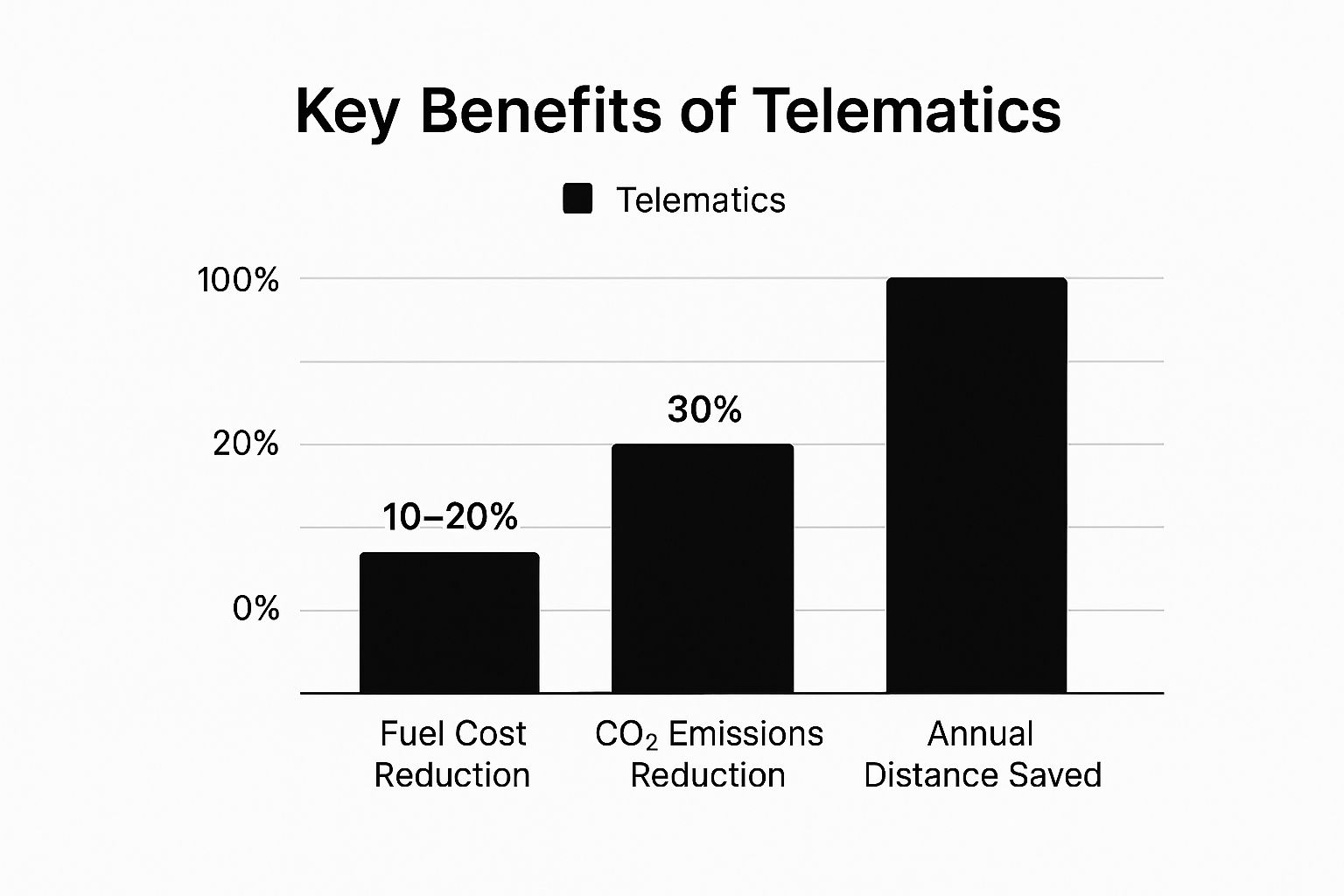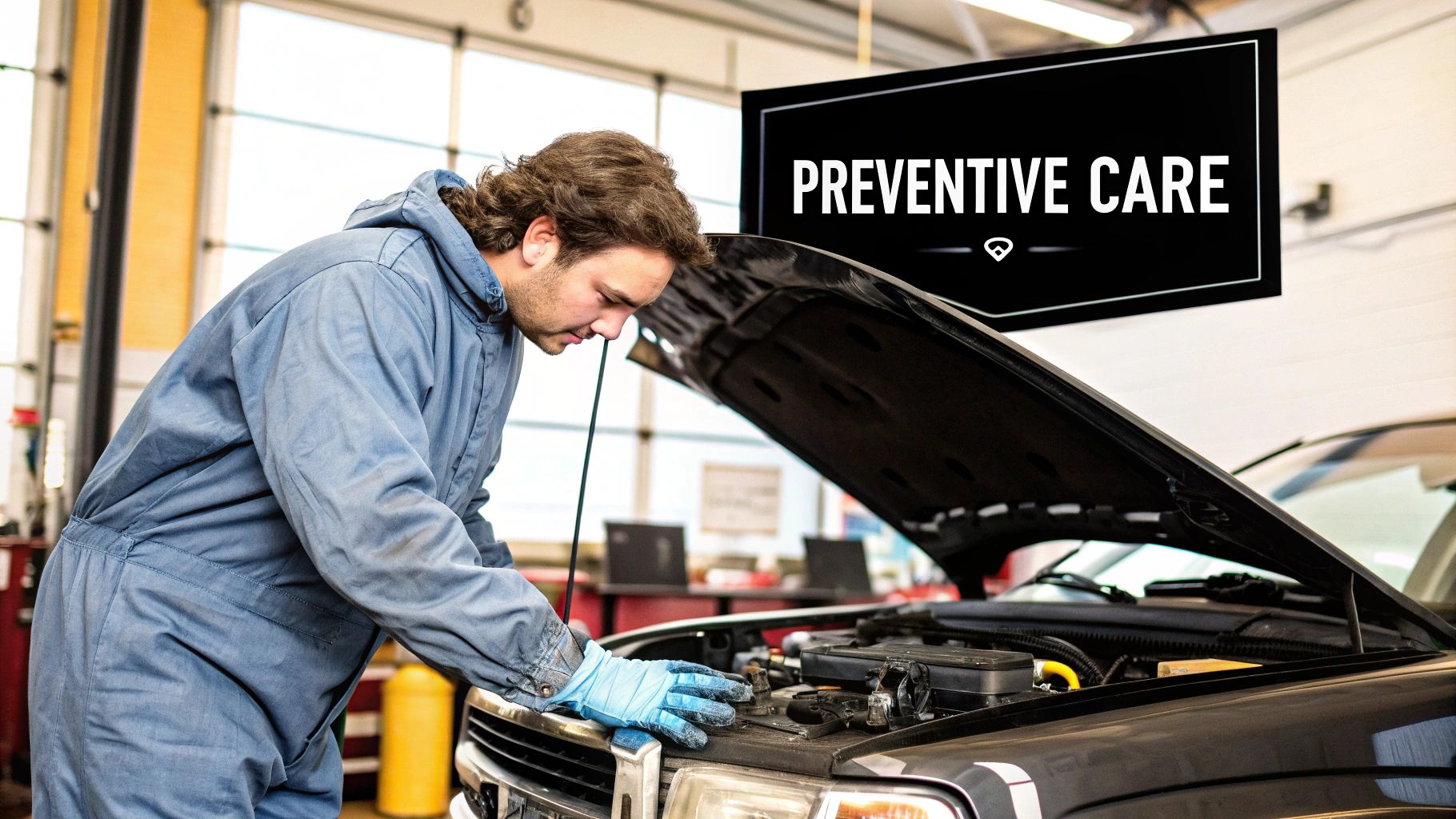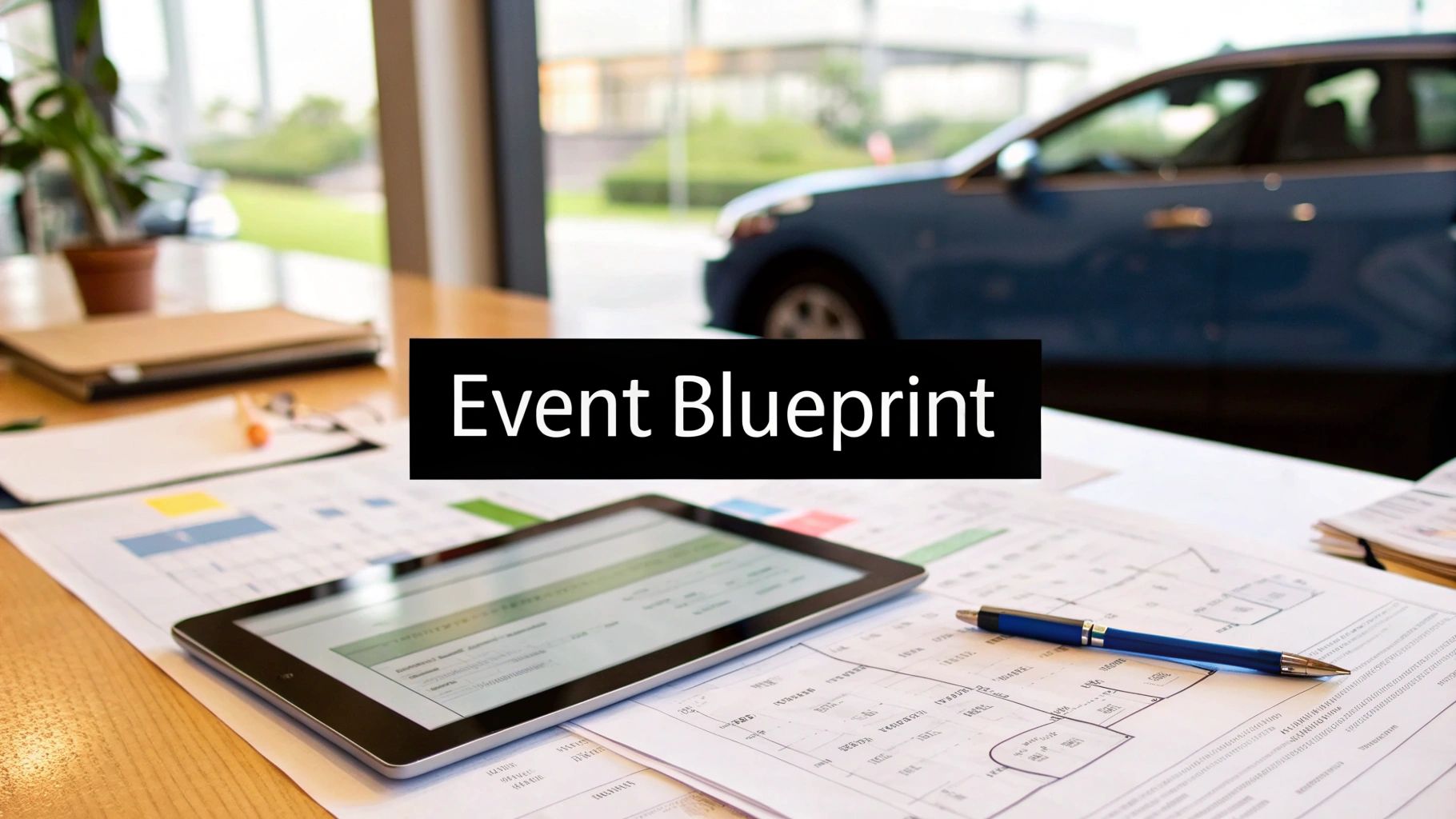In the competitive world of luxury chauffeured transportation, flawless service is the baseline. What truly sets an elite service apart, however, lies behind the scenes in the meticulous, data-driven strategies that govern the fleet. Standard vehicle management handles logistics; luxury fleet management orchestrates an impeccable client experience, ensuring every journey is seamless, safe, and sophisticated.
This article moves beyond generic advice to deliver nine essential fleet management best practices specifically tailored for high-end operators. We will provide actionable insights into how leveraging advanced technology, predictive maintenance, and strategic financial oversight can enhance operational efficiency and, more importantly, elevate the passenger journey. For any premium chauffeur service where punctuality, vehicle presentation, and safety are non-negotiable, mastering these practices is not just an operational goal-it is the core of the brand promise.
You will learn how to implement sophisticated systems that transform your operations from reactive to proactive. We will cover:
- Technology Integration: Implementing telematics and comprehensive data analytics.
- Proactive Maintenance: Moving from scheduled repairs to predictive upkeep.
- Performance Optimization: Focusing on driver training and fuel efficiency.
- Strategic Oversight: Managing vehicle lifecycles, compliance, and budgets effectively.
This guide provides a clear roadmap for refining your operations. Let's delve into the specific strategies that will define the leading luxury fleets and ensure your service delivers an unparalleled standard of excellence on every single trip.
1. Elevating the Client Experience with Precision Telematics and GPS Tracking
In the luxury chauffeured transport sector, superior fleet management best practices are defined by the client experience. Telematics and GPS tracking are no longer just operational tools; they are foundational technologies for delivering the punctuality, safety, and seamless communication that high-end clients expect. This technology moves beyond a simple dot on a map, providing real-time data on vehicle location, chauffeur driving habits, and traffic conditions.
This precision allows you to proactively manage every journey. Instead of reacting to delays, you can anticipate them, rerouting chauffeurs to avoid congestion and ensuring on-time arrivals. This capability is critical for airport transfers and time-sensitive corporate travel. For a deeper dive into the transformative power of location-based technologies, explore this comprehensive guide on GPS fleet management.
How to Implement Precision Tracking
Integrating advanced telematics is about more than just hardware installation. It involves a strategic shift in how you manage service delivery.
- Proactive Client Communication: Leverage GPS data to send automated pre-arrival notifications to clients, complete with a tracking link. This transparency builds trust and reduces client anxiety. For instance, Carey International uses this to provide real-time updates for peace of mind.
- Enhance Chauffeur Performance: Monitor metrics like speed, acceleration, and braking. Frame this data not as surveillance but as a tool for professional development, coaching chauffeurs to provide the smoothest, safest ride possible.
- Optimize Routes Strategically: Regularly analyze route data to identify more efficient or scenic paths. A luxury wine tour operator, for example, could use geofencing to automatically alert a vineyard of their imminent arrival, ensuring a prepared and welcoming reception for their clients.
This bar chart highlights key operational efficiencies gained from implementing telematics, demonstrating its impact beyond the client experience.


The data clearly shows that adopting precision tracking not only elevates service quality but also delivers significant operational cost savings and environmental benefits.
2. Predictive Maintenance Scheduling
In luxury transportation, vehicle reliability is non-negotiable. Predictive maintenance scheduling represents a paradigm shift from reactive repairs to proactive, data-driven care, making it one of the most critical fleet management best practices. This approach leverages vehicle data, onboard sensors, and advanced analytics to forecast maintenance needs before a component fails. Instead of adhering to a rigid, mileage-based schedule, this strategy ensures vehicles are serviced precisely when needed, maximizing uptime and preventing unexpected breakdowns that could jeopardize a high-stakes client engagement.
This forward-thinking methodology extends asset lifespan and enhances safety, ensuring every vehicle in your fleet performs flawlessly. Ryder System, for example, uses AI-driven maintenance to achieve an impressive 99.5% vehicle availability, a benchmark for reliability in the transportation sector. Beyond predictive strategies, ensuring consistent adherence to fundamental essential vehicle maintenance procedures forms a solid foundation for any advanced maintenance program.
How to Implement Predictive Maintenance
Adopting a predictive model involves integrating technology with refined operational protocols. The goal is to create a system that anticipates needs and automates responses, ensuring seamless vehicle readiness.
- Establish a Data Foundation: Begin by systematically tracking key metrics like mileage, engine hours, oil life, and tire pressure across your fleet. This initial data provides the baseline for building more complex predictive models.
- Invest in Technology and Training: Equip vehicles with telematics sensors that monitor engine diagnostics, fluid levels, and brake wear in real time. Crucially, invest in training for your maintenance staff to interpret this data and use new diagnostic tools effectively.
- Standardize Maintenance Protocols: Create clear, standardized service protocols for common alerts and predicted failures. This ensures consistency and efficiency, whether a vehicle is a luxury sedan or an executive SUV. For example, a specific diagnostic trouble code (DTC) should trigger a uniform, pre-defined inspection and repair process.
- Calibrate and Refine Models: Regularly compare the system's predictions with actual maintenance outcomes. Use this feedback loop to refine your predictive algorithms, increasing their accuracy over time and ensuring your maintenance schedule becomes progressively more efficient.


This proactive approach transforms the maintenance department from a cost center into a strategic asset, directly contributing to service excellence and operational profitability.
3. Championing Chauffeur Excellence Through Robust Training and Safety Programs
In the luxury transport sphere, the chauffeur is the ultimate brand ambassador. Therefore, one of the most critical fleet management best practices involves investing in continuous driver training and safety programs. This extends far beyond initial licensing; it's about cultivating a culture of excellence where safety, professionalism, and impeccable service are paramount. These programs use a combination of ongoing education, practical skill development, and behavioral coaching to minimize risks and perfect the client-facing experience.
A well-trained chauffeur not only avoids accidents but also operates the vehicle more smoothly and efficiently, enhancing passenger comfort and reducing wear and tear. For instance, Amazon has pioneered using virtual reality simulations for hazard recognition, while Swift Transportation's comprehensive safety initiatives led to a 35% reduction in accident frequency. This demonstrates that a structured approach to training delivers tangible results in both safety and service quality.


How to Implement Elite Chauffeur Training
Building an effective training program requires a strategic, multi-faceted approach that engages chauffeurs and addresses the specific demands of high-end service. The goal is to create professionals who are as skilled in defensive driving as they are in client etiquette.
- Make Training Relevant and Engaging: Move beyond static presentations. Use telematics data to create realistic training scenarios based on actual driving events from your fleet. Incorporate interactive workshops and on-road coaching from seasoned professionals.
- Focus on the 'Soft Skills': For a chauffeur service, training must cover more than just road safety. Develop modules on client communication, discretion, problem-solving, and anticipating passenger needs. Role-playing exercises can be invaluable for practicing these skills.
- Incentivize Professional Development: Link the completion of advanced training modules, like those offered by the Smith System, to tangible rewards. This could include performance bonuses, preferred vehicle assignments, or clear paths for career advancement, motivating chauffeurs to pursue excellence.
- Establish a Mentorship Program: Pair new hires with your most experienced and exemplary chauffeurs. This peer-to-peer learning fosters a strong team culture, accelerates skill acquisition, and ensures that institutional knowledge is passed down effectively.
4. Fuel Management and Efficiency Optimization
In the luxury transport business, where margins are as crucial as the client experience, controlling operational expenses is paramount. Fuel management represents one of the most significant opportunities for cost savings. Effective fuel management is a cornerstone of fleet management best practices, moving beyond simply filling the tank to a strategic, data-driven approach that minimizes consumption, reduces environmental impact, and enhances profitability.
This discipline involves a multi-faceted strategy encompassing route planning, chauffeur behavior, vehicle maintenance, and intelligent purchasing. For a luxury fleet, this isn't about cutting corners; it's about operating with a level of efficiency that mirrors the precision of the service provided. For example, UPS’s renowned policy of minimizing left turns saves the company millions of gallons of fuel annually by reducing idling time, a principle directly applicable to navigating busy urban environments like San Diego.
How to Implement Strategic Fuel Management
Integrating a robust fuel management program requires a commitment to monitoring data and fostering a culture of efficiency among your chauffeurs.
- Implement Smart Fuel Purchasing: Utilize fleet fuel cards, like those from FleetCor, to control and track every purchase. Set spending limits, restrict fuel types, and prevent unauthorized transactions. Consider fuel hedging strategies if your fleet is large enough to stabilize your budget against market volatility.
- Train for Eco-Driving Excellence: Coach chauffeurs on techniques that reduce fuel consumption while enhancing ride smoothness. This includes gradual acceleration, anticipating stops to avoid harsh braking, and minimizing engine idling. Frame this as a professional skill that contributes to a more serene client experience.
- Leverage Route Optimization Technology: Use advanced routing software from providers like Omnitracs to plan the most efficient paths. This technology should account for real-time traffic, road closures, and appointment times to minimize unnecessary mileage and idling, ensuring punctuality without wasted fuel.
- Commit to Proactive Maintenance: A well-maintained vehicle is a fuel-efficient one. Enforce a strict schedule for checking tire pressure, changing air filters, and performing regular engine tune-ups. Underinflated tires alone can significantly increase fuel consumption and compromise safety.
5. Comprehensive Fleet Data Analytics
In today's competitive luxury transport landscape, intuition-based decisions are no longer sufficient. Comprehensive fleet data analytics is one of the most critical fleet management best practices, involving the systematic collection, analysis, and interpretation of operational data to drive strategic decision-making. This transforms raw numbers from telematics, fuel cards, and maintenance logs into a clear roadmap for optimizing performance, cutting costs, and enhancing safety.
This practice moves beyond basic reporting to uncover hidden trends and predictive insights. By analyzing everything from fuel consumption patterns to vehicle downtime, you can pinpoint inefficiencies that are invisible on the surface. For instance, Penske Truck Leasing utilizes big data analytics to refine the operations of over 250,000 vehicles, while Enterprise Fleet Management uses predictive analytics to cut vehicle downtime by a significant 20%. This data-driven approach is essential for maintaining a competitive edge and delivering impeccable service.
How to Implement Data Analytics
Integrating data analytics requires a focused strategy to turn information into action, ensuring your fleet operates at peak efficiency.
- Start with Key Performance Indicators (KPIs): Avoid being overwhelmed by data. Begin by tracking a few crucial metrics relevant to luxury transport, such as idle time per vehicle, cost-per-mile, and on-time performance rates. This focused approach provides clear, actionable insights without unnecessary complexity.
- Ensure Data Integrity: The accuracy of your analysis depends on the quality of your data. Regularly audit your data sources, like telematics systems and maintenance software such as Fleetio, to ensure consistency and eliminate errors. High-quality data leads to reliable, trustworthy conclusions.
- Create Role-Specific Dashboards: Not everyone needs to see every metric. Develop customized dashboards using tools like Tableau or Microsoft Power BI. Your fleet manager might focus on maintenance schedules and fuel efficiency, while dispatchers see real-time vehicle status and route optimization data.
- Establish Regular Data Reviews: Schedule weekly or bi-weekly meetings with your team to review the data, discuss trends, and set actionable goals. This practice ensures that insights are translated into concrete operational improvements and fosters a culture of continuous improvement.
6. Strategic Vehicle Lifecycle Management
In the luxury transportation industry, the elegance and reliability of your fleet are paramount. Strategic Vehicle Lifecycle Management is a comprehensive approach that moves beyond simple purchasing and selling, focusing on optimizing the total cost of ownership from acquisition through disposal. This practice ensures your fleet remains modern and pristine while maximizing financial efficiency and extracting maximum value at every stage.
This holistic view balances operational demands with long-term financial health. By treating vehicles as assets with a defined lifecycle, you can make data-driven decisions on when to acquire, maintain, and replace them, preventing the use of aging vehicles that could tarnish your brand's premium image. For instance, major players like ARI and Donlen have perfected this model, using predictive analytics to optimize the lifecycles of millions of vehicles, a core component of their fleet management best practices.
How to Implement Strategic Lifecycle Management
Adopting this strategy involves a disciplined, data-centric approach to managing your most significant assets. It's about planning for the entire journey of a vehicle within your fleet, not just its day-to-day operations.
- Establish Clear Replacement Criteria: Develop a consistent policy for vehicle replacement based on a combination of age, mileage, and total maintenance costs. This removes guesswork and prevents unexpected, costly breakdowns that could impact a high-profile client engagement.
- Track Total Cost of Ownership (TCO): Diligently monitor all associated costs, including fuel, insurance, maintenance, repairs, and depreciation. This comprehensive data provides the true cost of operating each vehicle, identifying the optimal point at which replacement becomes more cost-effective than continued maintenance.
- Monitor Resale Markets: Actively track resale values and seasonal trends to time your vehicle disposals for maximum return. Selling a luxury sedan just before a new model year is announced, for example, can significantly enhance its resale value.
- Standardize Vehicle Specifications: Where possible, standardize your fleet with specific makes, models, and upfits. This not only simplifies maintenance and driver training but also improves resale values, as standardized vehicles are often more attractive on the secondary market.
7. Regulatory Compliance and Documentation Management
In the highly regulated world of luxury transportation, one of the most critical fleet management best practices is maintaining impeccable regulatory compliance and documentation. This involves more than just meeting minimum legal standards; it's about building a systematic framework that ensures every vehicle and chauffeur operates in full accordance with federal, state, and local laws. A robust compliance strategy minimizes legal risks, prevents costly fines, and upholds the operational integrity essential for a premium brand.
This systematic approach prevents operational disruptions that could tarnish your reputation, such as a vehicle being pulled from service during a surprise inspection. Companies like Schneider National have demonstrated the power of this focus, using automated platforms to significantly reduce compliance violations. Beyond regulatory mandates, leveraging effective electronic document management systems ensures that all fleet-related records, from vehicle registrations to maintenance logs, are securely stored and easily accessible, greatly enhancing compliance efforts.
How to Implement a Robust Compliance Framework
Building an airtight compliance program requires a proactive, technology-driven approach that integrates documentation into daily operations. This ensures that compliance is a continuous process, not a periodic scramble.
- Automate and Centralize Records: Implement a digital system to track and manage compliance deadlines for vehicle inspections, chauffeur license renewals, and insurance updates. Platforms like Omnitracs provide solutions that automate these alerts, preventing critical dates from being missed.
- Conduct Regular Internal Audits: Proactively schedule and perform internal audits of all compliance-related documentation, from driver logs to maintenance records. This practice helps identify and rectify potential issues before they can be flagged by external auditors from agencies like the DOT or FMCSA.
- Prioritize Continuous Training: Ensure all chauffeurs and administrative staff receive ongoing training on compliance requirements and any new legislative updates. This empowers your team to be the first line of defense in maintaining a compliant operation, reinforcing a culture of safety and professionalism.
8. Cost Control and Budget Management
In the luxury transport industry, where premium service is non-negotiable, meticulous financial oversight is the bedrock of profitability and sustainability. Effective cost control and budget management are fleet management best practices that go beyond simple expense tracking. They involve a strategic, proactive approach to monitoring, optimizing, and justifying every dollar spent, from fuel and maintenance to insurance and chauffeur wages, ensuring that operational excellence doesn't lead to financial inefficiency.
This comprehensive financial discipline allows you to maintain the highest standards of service while protecting your margins. By understanding the total cost of ownership (TCO) for each vehicle and analyzing expenses on a granular level, you can make informed decisions about vehicle acquisition, service intervals, and supplier contracts. For example, giants like FedEx and Amazon leverage integrated cost control systems to manage billions in annual transportation expenses, proving that financial rigor is scalable and essential at every level of operation.
How to Implement Strategic Cost Control
Integrating robust budget management requires a shift from reactive spending to proactive financial planning, turning cost centers into opportunities for efficiency.
- Implement Granular Cost Tracking: Use fleet management software to track every expense category, such as fuel, maintenance, tires, insurance, and depreciation. Tag each cost to a specific vehicle to calculate an accurate cost-per-mile metric, a vital KPI for performance measurement.
- Negotiate and Consolidate Suppliers: Leverage your total operational spend to negotiate volume discounts with key vendors, including fuel card providers, maintenance shops, and insurance brokers. Consolidating suppliers can lead to better rates and simplified administrative overhead.
- Establish Budgetary Thresholds: Create clear approval workflows for expenses. For instance, a chauffeur might have autonomy for fuel fill-ups, but a maintenance repair over $500 could require manager approval. This prevents budget overruns and encourages cost-conscious decision-making across the team.
9. Technology Integration and Digital Transformation
In the luxury transport landscape, digital transformation is not a future concept; it's a present-day necessity. This practice involves the strategic integration of emerging technologies like AI, IoT, and advanced mobile applications to fundamentally modernize fleet operations. It moves beyond simply adopting new software, focusing instead on creating a cohesive digital ecosystem where data flows seamlessly between vehicles, chauffeurs, and your back-office systems, creating significant competitive advantages.
This strategic shift allows you to automate routine tasks, gain deeper operational insights, and deliver a hyper-personalized client experience. For instance, AI can optimize dynamic pricing based on demand and traffic, while integrated apps provide clients with unparalleled control over their journey. This level of sophistication is a key differentiator in a crowded market and a cornerstone of modern fleet management best practices. For an in-depth look at how technology is shaping logistics, consider Amazon's continuous innovation in its delivery network.
How to Implement Digital Transformation
Integrating advanced technology requires a clear roadmap and a commitment to evolving your operational model. It's about building a smarter, more connected, and more responsive service.
- Develop a Phased Technology Roadmap: Avoid overwhelming your operations. Start by identifying key pain points, such as booking friction or dispatch inefficiency, and prioritize technologies that solve these specific issues. Define clear ROI expectations for each phase before moving to the next.
- Prioritize Cybersecurity from Day One: As you integrate more connected systems, you expand your digital footprint. Ensure all technology decisions, from client apps to vehicle IoT devices, include robust cybersecurity measures to protect sensitive client and company data.
- Invest in Comprehensive Training: Technology is only as effective as the team using it. Implement thorough training and change management programs to ensure your chauffeurs and administrative staff are confident and competent with new platforms, turning them into advocates for the new system.
- Choose Scalable, Integrated Solutions: Select technology partners that offer platforms with strong APIs and integration capabilities. This ensures that your booking software, dispatch system, and telematics can communicate, eliminating data silos and creating a unified operational view.
Best Practices Comparison Matrix for 9 Fleet Management Areas
| Solution | Implementation Complexity 🔄 | Resource Requirements 📊 | Expected Outcomes ⭐📊 | Ideal Use Cases 💡 | Key Advantages ⚡⭐ |
|---|---|---|---|---|---|
| Telematics and GPS Tracking | Moderate to High 🔄 | GPS devices, software subscriptions, training | Improved fleet visibility, fuel savings (10-20%), safety improvement ⭐📊 | Real-time tracking, route optimization, driver behavior monitoring | Fuel cost reduction, safety improvements, theft protection ⚡⭐ |
| Predictive Maintenance Scheduling | High 🔄 | IoT sensors, ML software, skilled technicians | Reduced breakdowns (up to 70%), extended vehicle life (20-40%) ⭐📊 | Preventive maintenance, reducing downtime and costs | Higher uptime, cost control, proactive safety improvements ⚡⭐ |
| Driver Training and Safety Programs | Moderate 🔄 | Training materials, simulators, ongoing programs | Reduced accidents (20-50%), insurance savings, compliance ⭐📊 | Driver performance, safety compliance, fuel efficiency | Lower accidents, improved reputation, regulatory compliance ⚡⭐ |
| Fuel Management and Efficiency Optimization | Moderate 🔄 | Monitoring tech, fuel cards, training | Fuel cost reduction (15-30%), lower emissions ⭐📊 | Fuel monitoring, route and driver behavior optimization | Significant fuel savings, environmental impact reduction ⚡⭐ |
| Comprehensive Fleet Data Analytics | High 🔄 | Data platforms, analytics expertise | Data-driven decisions, cost reduction, improved planning ⭐📊 | Performance monitoring, strategic decision making | Enhanced insights, benchmarking, compliance support ⚡⭐ |
| Strategic Vehicle Lifecycle Management | High 🔄 | Financial models, market data, expertise | Maximized vehicle value, reduced depreciation ⭐📊 | Vehicle acquisition, replacement timing, total cost management | Optimized TCO, better budgeting, sustainability support ⚡⭐ |
| Regulatory Compliance and Documentation Management | Moderate 🔄 | Compliance software, training, document management | Avoid fines, ensure permits, reduce liability ⭐📊 | Regulatory adherence, audit readiness | Legal risk reduction, process streamlining, reputation protection ⚡⭐ |
| Cost Control and Budget Management | Moderate to High 🔄 | Accounting systems, detailed tracking | Expense visibility, cost control, financial planning ⭐📊 | Expense management, budgeting, vendor negotiation | Cost savings, improved forecasting, informed decisions ⚡⭐ |
| Technology Integration and Digital Transformation | High 🔄 | Advanced tech (AI, IoT), cloud platforms, training | Enhanced efficiency, real-time monitoring, scalability ⭐📊 | Modernizing fleet operations, competitive advantage | Operational agility, reduced admin, customer service boost ⚡⭐ |
Integrating Best Practices for a Flawless Journey
Navigating the landscape of luxury chauffeured transportation requires more than just premium vehicles; it demands a commitment to operational excellence. Throughout this guide, we have explored nine foundational pillars that constitute the elite tier of fleet management best practices. These are not isolated tactics to be implemented piecemeal. Instead, they represent a holistic, interconnected framework designed to elevate every facet of your service, from backstage logistics to the client-facing experience.
The journey from a functional fleet to a flawless one begins with the integration of these core principles. Think of them as a symphony of moving parts. Your telematics and GPS tracking are the rhythm section, providing the real-time data that sets the tempo for your entire operation. Predictive maintenance scheduling acts as the conductor, anticipating needs and ensuring every vehicle performs perfectly on cue. This proactive approach prevents the jarring interruptions that can tarnish a luxury brand's reputation.
Simultaneously, your investment in comprehensive driver training and safety programs ensures that the human element of your service is as polished and reliable as the machinery. A well-trained chauffeur is more than a driver; they are an ambassador for your brand, capable of delivering a secure, comfortable, and memorable journey. This dedication to safety and professionalism is reinforced by rigorous fuel and cost management strategies, which ensure your operation remains financially healthy and sustainable without compromising on quality.
From Data to Dominance: A Strategic Imperative
The true power of modern fleet management lies in transforming raw data into actionable intelligence. This is where a deep dive into fleet analytics becomes non-negotiable. By analyzing patterns in fuel consumption, driver behavior, and vehicle wear, you can make informed, strategic decisions that optimize efficiency and reduce operational overhead. This data-driven mindset is the cornerstone of strategic vehicle lifecycle management, guiding you on the optimal timing for vehicle acquisition, maintenance, and eventual retirement to maximize return on investment.
Furthermore, seamless regulatory compliance and meticulous documentation management are not just legal necessities; they are reflections of your company's professionalism. For clients in San Diego seeking premier airport transportation or private car services, the assurance that their chosen provider operates with unimpeachable integrity is a significant factor in their decision-making process.
Ultimately, all these practices converge under the umbrella of a complete digital transformation. Embracing technology isn't just about adopting the latest software; it's about creating a cohesive digital ecosystem where every component, from dispatch to billing, communicates seamlessly. This integration eliminates friction, reduces the potential for human error, and empowers your team to focus on what truly matters: delivering an unparalleled client experience.
Mastering these fleet management best practices is an ongoing journey, not a final destination. It is a continuous cycle of implementation, analysis, and refinement. By weaving these nine strategies into the fabric of your operations, you build a resilient, efficient, and sophisticated system that doesn't just meet client expectations-it consistently exceeds them. The result is not just a well-managed fleet but a powerful engine for brand loyalty and market leadership.
Ready to experience the pinnacle of luxury transportation that comes from exceptional fleet management? See how these principles translate into an impeccable, stress-free journey with Pompeii Limousine. Our commitment to these best practices ensures every ride is a testament to safety, reliability, and unparalleled comfort. Book your next luxury transfer with Pompeii Limousine and travel with absolute confidence.



